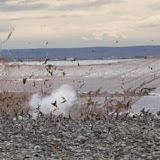Chile - Bahia Lomas, Tierra del Fuego, January 30, 2007

We started the day taking care of all the work necessary to maintain a life without all of the amenities taken for granted in our normal lives. Our water must be transported 20 miles from Cerro Sombrero, the nearest, our septic system is a dug latrine, personal hygiene in cold water and dishpans and laundry by hand. At least we’ve had a spate of good weather although it has been frequently punctuated by brief rain showers and stiff cold winds. Still it’s a welcome change from the previous week’s bitter weather.
After lunch on Monday, we made our way out to the Red Knot roost by truck. At four hours before low water, the knots were still feeding on the mussel beds and just starting to roost. On two successive days, we observed only 2,500 knots, not the 5,000 seen in aerial count, a discrepancy that has provoked some discussion. On the previous day, Sunday, we had observed the knots and White-rumped Sandpipers roosting two hours before high and marked a suitable location for the cannon net. We set our cannon net close to the spot, allowing for a 10 inch decrease in the high tide line predicted by the tide charts. We did our best to disguise the net by placing it in a shallow trench and covering it with kelp leaves.
As it turned out, the knots failed to land in the catching area of our net, but with some expert twinkling (gently moving birds towards the net) by Mark and before the rising tide flooded the net, we fired and caught 125 knots, 6 Hudsonian Godwits and two White-rumped Sandpipers. After many attempts, this was our first successful cannon net capture for four years. Despite the fact that we spent the next three hours processing the birds in a bitterly cold winds, the team was pleased. We retrapped several birds that were already banded. These included one bird that had been banded in NJ in May 1998 as an adult. As adults are at least two years old, the minimum age of this bird was 11 years. Therefore, at 20,000 miles a year, this bird had logged over 220,000 migration miles or equivalent to flying to the moon. Other recaptures:
Flag Green Reeds Beach NJ May 21st ,1998
Flag Green North Bowers Beach, DE, May 29th 1999
Flag Lime (puu) Reeds Beach, NJ May 31st 2005
3 Flag Red Strait of Magellan/Bahia Lomas, Chile Feb 5th 2002
Flag Red Bahia Lomas, Chile Feb 8th 2004
Flag Orange unknown origin and date from Argentina
On Sunday, Carmen’s students Gabriela and Sergio began a study of the diet and intake rates of the knots that appear to be feeding mainly on mussels. They are recording the rate at which the birds swallow prey items and will determine the size and type of prey by analyzing the contents of the birds’ droppings.
On Tuesday, Mark and Steve continued observations of the Bahia Azul knot flock, while Humphrey and I investigated the other 5,000 knot roost discovered during the aerial survey. It had been located on the north side of the Straits of Magellan, about 10 km from Bahia Azul. After the 30-minute ferry ride and a few hours of riding the dusty back roads of the grassy steppe surrounding the Strait, we found the shingle spit which jutted 500 meters into the sea. It was surrounded by extensive mussel beds. But we only saw 400 knots. The discrepancy between our ground counts and the aerial count was becoming more and more apparent, so we decided to do a systematic all bay ground count on Wednesday.
Another important objective of our expedition is to develop final plans for the creation of a new center dedicated to the study of shorebirds on Bahia Lomas. We have already had preliminary discussions with the mayor of the municipality of Primavera, Ricardo Olea, who has whole heartedly embraced the idea of the center. Jorge Jordan, a key businessman in Punta Arenas, has already set up a Chilean foundation to receive the money. It only remains for us to finalize the plans for the center and the foundation. Tomorrow we will meet with the Administrator of the municipality, and in a few days firm up on our plans with Jorge.


0 Comments:
Post a Comment
Subscribe to Post Comments [Atom]
<< Home